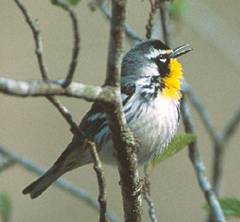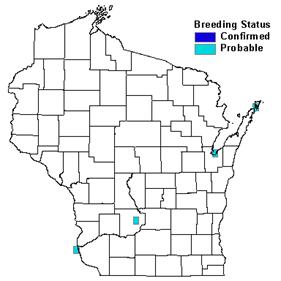Photo by Dennis Malueg


Status/Protection
- Global Rank: G5 Key to global and state ranks
- State Rank: S1B
- WBCI Priority: SGCN, State Endangered
Population Information
Federal BBS information can be obtained at http://www.mbr-pwrc.usgs.gov/bbs/bbs.html by clicking on Trend Estimates and selecting the species in question. All estimates are for 1966-2005.
- Federal Breeding Bird Survey: significant increase
- Federal Breeding Bird Survey (WI): N/A
- Federal Breeding Bird Survey (BCR 23): N/A
- Federal Breeding Bird Survey (BCR 12): N/A
- WSO Checklist Project: N/A
Life History
- Breeding Range: Extreme southern Wisconsin south to eastern Texas east to the Atlantic Coast (Hall 1996).
- Breeding Habitat: Bottomland Hardwood, riparian woodland with sycamore.
- Nest: Cup, in periphery of upper canopy.
- Nesting Dates: Poorly known in Wisconsin; late April to mid-June elsewhere in range.
- Foraging: Probes, hawks (Ehrlich et al. 1988).
- Migrant Status: Short-distance migrant, Neotropical migrant.
- Habitat use during Migration: Woodlands with tall trees; parklands.
- Arrival Dates: Late April to late May (Robbins 1991).
- Departure Dates: Not well known.
- Winter Range: Southeast U.S., coastal eastern Mexico, and Central America north of Panama.
- Winter Habitat: Open woodlands and second-growth habitats.
Habitat Selection
The Yellow-throated Warbler varies considerably in its habitat preference across its range, with studies from southeastern populations poorly reflecting behavior in Wisconsin. Throughout much of its range, the Yellow-throated Warbler inhabits cypress swamps and pine-oak uplands (Hall 1996, Gabbe et al. 2002). In Wisconsin, however, this species occurs almost exclusively in bottomland forest containing large sycamores (Robbins 1991, Hall 1996). Nests are generally in the forest canopy, located on horizontal branches 2-3 meters away from main trunk (Butler 1928, Hall 1996), and often are placed in clumps of leaves or Spanish moss (Hall 1996).
During migration, the Yellow-throated Warbler uses a wide variety of woodlands with tall trees, including parklands (Hall 1996). Winter habitats range from coastal dune scrub in Yucatan (Lynch 1992) to pine woodlands in Jamaica (Lack 1976) and Honduras (Monroe 1968). Throughout its range in winter, Yellow-throated Warbler extensively uses second-growth and disturbed woodlands (Tramer 1974).
Habitat Availability
Wisconsin is on the extreme northern edge of the Yellow-throated Warbler’s breeding range (Hall 1996). It is a rare migrant and summer resident in the state (Robbins 1991). Since the 1970s, it has been reported more frequently in Wisconsin (Robbins 1991), and is suspected to be expanding its breeding range northward. This species has a history of retraction from northern limit of breeding range followed by period of expansion of that limit, but reasons for this are not apparent (Hall 1996). Breeding has been confirmed only in floodplain forests with a sycamore component along the Sugar River in Rock County (Mossman 1988, Robbins 1991), but is suspected in Wyalusing State Park as well (Hansen 2006). Bottomland hardwood and other floodplain forests have fared better than many of Wisconsin’s native habitats due to the difficulty of converting them to other land uses. Nevertheless, only 8% of presettlement floodplain forest remains in moderate to high quality condition (Mossman 1988).
Population Concerns
Breeding Bird Survey (BBS) data suggest a significant population increase range-wide for this species. However, its status is not well known in Wisconsin where it is not adequately monitored by BBS methodology (Sauer et al. 2005). The Wisconsin Breeding Bird Atlas (1995-2000) produced few data on this species. Atlas observers documented probable breeding from only a single quad in Grant County and failed to confirm nesting anywhere in the state (Hansen 2006).
Loss or degradation of sycamore stands within Wisconsin’s southern bottomland hardwood forests would threaten this species’ tenuous hold here (WDNR 2005). Yellow-throated Warblers do not appear to be limited on the wintering grounds (Hall 1996).
Recommended Management
Conservation of the few remaining sycamore stands in southern Wisconsin is recommended. Where appropriate, managers should consider restoring a sycamore component to floodplain forests along the Sugar, Mississippi, and Wisconsin rivers. Conservation and management strategies for this species should focus in the Southeast Glacial Plains and Western Coulee and Ridges ecological landscapes of Wisconsin (WDNR 2005).
Research Needs
This species has been little studied. Much basic biological information is needed, including data on breeding behavior and timing. In Wisconsin, targeted surveys in suitable riparian woodlands of southern Wisconsin would help to elucidate its status in the state.
Information Sources
- Cornell Lab of Ornithology species account: http://www.birds.cornell.edu/AllAboutBirds/BirdGuide/Yellow-throated_Warbler.html
- Patuxent Bird Identification Center: http://www.mbr-pwrc.usgs.gov/id/framlst/i6630id.html
- North American Breeding Bird Survey: http://www.mbr-pwrc.usgs.gov/bbs/bbs.html
- Wisconsin Breeding Bird Atlas: http://www.uwgb.edu/birds/wbba/
References
- Butler, A.W. 1928. Nesting of the Sycamore Warbler. Auk 45: 224–225.
- Ehrlich, P.R., D.S. Dobkin, and D. Wheye. 1988. The birders handbook: a field guide to the natural history of North American birds. Simon & Schuster, Inc. New York.
- Gabbe, A.P., S.K. Robinson, and J.D. Brawn. 2002. Tree-species preferences of foraging insectivorous birds: implications for floodplain forest restoration. Cons. Biol. 16(2): 462-470.
- Hall, G.A. 1996. Yellow-throated Warbler. The Birds of North America, No. 223 (A. Poole and F. Gill, eds.). The Birds of North America, Inc., Philadelphia, PA.
- Hansen, J. 2006. Yellow-throated Warbler. In Atlas of the Breeding Birds of Wisconsin. (N.J. Cutright, B.R. Harriman, and R.W. Howe, eds.) The Wisconsin Society for Ornithology, Inc. 602pp.
- Lack, D. 1976. Island biology. Univ. of California Press, Berkeley.
- Lynch, J.F. 1992. Distribution of overwintering Nearctic migrants in Yucatan. Pp 178-196 In: Hagan, J. M. III, and D. W. Johnston [eds.]. Ecology and conservation of Neotropical migrant landbirds. Smithson. Inst. Press, Washington, D.C.
- Mossman, M.J. 1988. Birds of southern Wisconsin floodplain forests. Passenger Pigeon 50: 321-337.
- Robbins, S.D., Jr. 1991. Wisconsin birdlife: Population and distribution past and present. Madison, WI: Univ. Wisconsin Press.
- Sauer, J.R., J.E. Hines, and J. Fallon. 2005. The North American Breeding Bird Survey, Results and Analysis 1966 - 2005. Version 6.2.2006. USGS Patuxent Wildlife Research Center, Laurel, MD.
- Tramer, E.J. 1974. Proportions of wintering North American birds in disturbed and undisturbed dry tropical habitats. Condor 76: 460–463.
- Wisconsin Department of Natural Resources (WDNR). 2005. Wisconsin’s Strategy for Wildlife Species of Greatest Conservation Need. Madison, WI.
Contact Information
- Compiler: Tom Klubertanz, tklubert@uwc.edu
- Editors: Kim Kreitinger, K.Kreitinger@gmail.com
